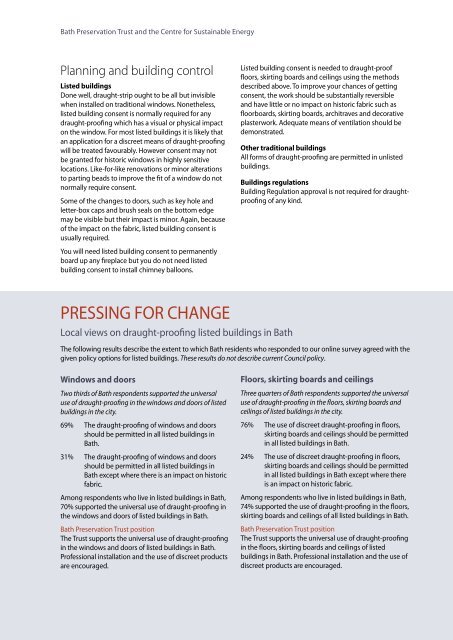Warmer Bath
Create successful ePaper yourself
Turn your PDF publications into a flip-book with our unique Google optimized e-Paper software.
<strong>Bath</strong> Preservation Trust and the Centre for Sustainable Energy<br />
Planning and building control<br />
Listed buildings<br />
Done well, draught-strip ought to be all but invisible<br />
when installed on traditional windows. Nonetheless,<br />
listed building consent is normally required for any<br />
draught-proofing which has a visual or physical impact<br />
on the window. For most listed buildings it is likely that<br />
an application for a discreet means of draught-proofing<br />
will be treated favourably. However consent may not<br />
be granted for historic windows in highly sensitive<br />
locations. Like-for-like renovations or minor alterations<br />
to parting beads to improve the fit of a window do not<br />
normally require consent.<br />
Some of the changes to doors, such as key hole and<br />
letter-box caps and brush seals on the bottom edge<br />
may be visible but their impact is minor. Again, because<br />
of the impact on the fabric, listed building consent is<br />
usually required.<br />
Listed building consent is needed to draught-proof<br />
floors, skirting boards and ceilings using the methods<br />
described above. To improve your chances of getting<br />
consent, the work should be substantially reversible<br />
and have little or no impact on historic fabric such as<br />
floorboards, skirting boards, architraves and decorative<br />
plasterwork. Adequate means of ventilation should be<br />
demonstrated.<br />
Other traditional buildings<br />
All forms of draught-proofing are permitted in unlisted<br />
buildings.<br />
Buildings regulations<br />
Building Regulation approval is not required for draughtproofing<br />
of any kind.<br />
You will need listed building consent to permanently<br />
board up any fireplace but you do not need listed<br />
building consent to install chimney balloons.<br />
PRESSING FOR CHANGE<br />
Local views on draught-proofing listed buildings in <strong>Bath</strong><br />
The following results describe the extent to which <strong>Bath</strong> residents who responded to our online survey agreed with the<br />
given policy options for listed buildings. These results do not describe current Council policy.<br />
Windows and doors<br />
Two thirds of <strong>Bath</strong> respondents supported the universal<br />
use of draught-proofing in the windows and doors of listed<br />
buildings in the city.<br />
69% The draught-proofing of windows and doors<br />
should be permitted in all listed buildings in<br />
<strong>Bath</strong>.<br />
31% The draught-proofing of windows and doors<br />
should be permitted in all listed buildings in<br />
<strong>Bath</strong> except where there is an impact on historic<br />
fabric.<br />
Among respondents who live in listed buildings in <strong>Bath</strong>,<br />
70% supported the universal use of draught-proofing in<br />
the windows and doors of listed buildings in <strong>Bath</strong>.<br />
<strong>Bath</strong> Preservation Trust position<br />
The Trust supports the universal use of draught-proofing<br />
in the windows and doors of listed buildings in <strong>Bath</strong>.<br />
Professional installation and the use of discreet products<br />
are encouraged.<br />
Floors, skirting boards and ceilings<br />
Three quarters of <strong>Bath</strong> respondents supported the universal<br />
use of draught-proofing in the floors, skirting boards and<br />
ceilings of listed buildings in the city.<br />
76% The use of discreet draught-proofing in floors,<br />
skirting boards and ceilings should be permitted<br />
in all listed buildings in <strong>Bath</strong>.<br />
24% The use of discreet draught-proofing in floors,<br />
skirting boards and ceilings should be permitted<br />
in all listed buildings in <strong>Bath</strong> except where there<br />
is an impact on historic fabric.<br />
Among respondents who live in listed buildings in <strong>Bath</strong>,<br />
74% supported the use of draught-proofing in the floors,<br />
skirting boards and ceilings of all listed buildings in <strong>Bath</strong>.<br />
<strong>Bath</strong> Preservation Trust position<br />
The Trust supports the universal use of draught-proofing<br />
in the floors, skirting boards and ceilings of listed<br />
buildings in <strong>Bath</strong>. Professional installation and the use of<br />
discreet products are encouraged.<br />
40


